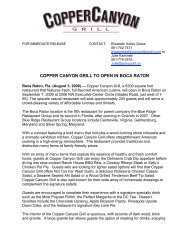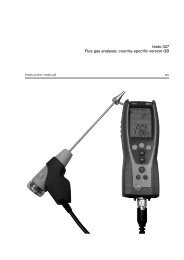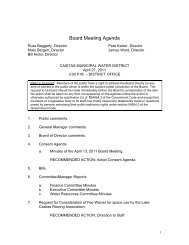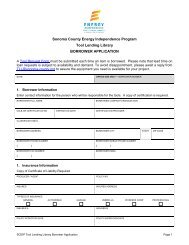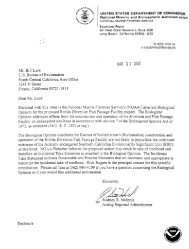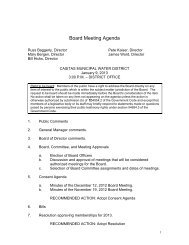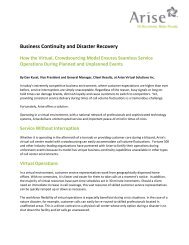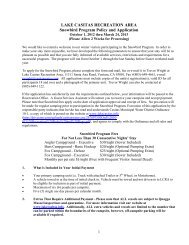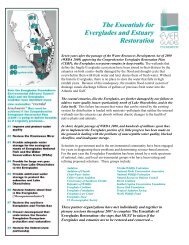Russian River County Sanitation District - DriveCMS
Russian River County Sanitation District - DriveCMS
Russian River County Sanitation District - DriveCMS
Create successful ePaper yourself
Turn your PDF publications into a flip-book with our unique Google optimized e-Paper software.
SONOMACOUNTYJennerGuernvilleBodega BayCloverdaleLake Sonoma101<strong>Russian</strong> <strong>River</strong>1BodegaHealdsburgWindsor116Sebastopolol12RUSSIAN RIVER COUNTY SANITATION N DISTRICTTService AreaSantaRosa1011CotatiRohnert ParkPetalumaThe RRCSDService AreaThe RRCSD service area covers approximately2,700 acres and includes the unincorporated areas ofRio Nido, Guerneville, Guernewood Park, and VacationBeach. The RRCSD treatment plant provides service toapproximately 3,300 parcels using a gravity collectionsystem and treats wastewater from approximately3,200 equivalent single-family dwellings.The treatment plant cleans the community’swaste water to tertiary recycled-water standards(also referred to as advanced water treatment), whichis the highest level of treatment defined by the Stateof California (referred to as Title 22). This level oftreatment allows for unrestricted reuse in virtuallyall recycled-water applications.Wastewater goes through three treatment stepsbefore it is considered tertiary recycled water: primarytreat ment, biological treatment (secondary), andfiltration (tertiary). This is followed by disinfection,whereby chlorine is used to destroy pathogenic microorganisms.These steps are necessary before tertiaryrecycled water is used for agricultural or landscapeirrigation or released into the <strong>Russian</strong> <strong>River</strong>.NGUERNEVILLERI V E R116GuernewoodParkR O A DVacationBeachSR U SRio NidoI A NE RR I V116<strong>Russian</strong> <strong>River</strong> CSDTreatment PlantBetween October 1 and May 14, tertiary recycled waterfrom the treatment plant is discharged into the <strong>Russian</strong><strong>River</strong>. Between May 15 and September 30, the recycledwater is used to irrigate the Northwood Golf Courseand forests outside the plant.Sonoma <strong>County</strong> Water Agency’s RoleDuring a 1995 restructuring of thecounty government, the Sonoma <strong>County</strong>Water Agency assumed responsibility formanaging the county sanitation zonesand districts, which provide wastewatertreatment, reclamation, and disposalfor approximately 22,000 residences and businesses.Because some local wastewater treatment plants havenot been significantly improved in more than 20 years,capital projects are needed to ensure compliance withstate and federal treatment and discharge requirements.Each sanitation zone and district operatesunder a unique, individual permit from the CaliforniaRegional Water Quality Control Board (San Franciscoand North Coast regions) that sets the requirements foroperation. The RRCSD operates under a permit from theNorth Coast Regional Water Quality Control Board.About Recycled WaterNature has recycled water for millions of years.By duplicating much of nature’s process through tertiarytreatment, we are able to purify water to ensure that it meetsthe strict standards set by the California Department of PublicHealth. There are very stringent water-quality laws that applyto recycled water. The state standards for recycled waterare referred to as Title 22 and are incorporated in Title 22,Chapter 3, Division 4 of the California Code of Regulations,with stipulations applying to various types of reuse and levelsof required treatment. The Regional Water Quality ControlBoard regulates the use and the application of recycled waterand any associated runoff.Title 22 allows for many uses of recycled water, includingirrigation of food crops, orchards, and vineyards as well asparks, playgrounds, cemeteries, schoolyards, residentiallandscaping, freeway landscaping, golf courses, ornamentalnurseries, and pasture for animals. Recycled water can also beused for fish hatcheries, cooling towers, decorative fountains,and fishing or boating recreational impound ments. Otherallowable uses include industrial processing, commerciallaundries, soil compaction, mixing concrete, making artificialsnow, and flushing toilets, urinals, and sanitary sewers.State health officials monitor the recycled water produced byRRCSD to ensure that it meets federal, state, and local waterqualitystandards. Recycled water is transported througha system of purple pipes, completely separate from thedrinking-water and wastewater systems.It’s important to note that recycled water is cheaper thanpotable water and, in the case of drought, is a more reliablesupply. For more information about recycled water, visitwww.sonomacountywater.org.RRCSD Board of DirectorsValerie Brown, First <strong>District</strong> SupervisorMike Kerns, Second <strong>District</strong> SupervisorShirlee Zane, Third <strong>District</strong> SupervisorPaul L. Kelley, Fourth <strong>District</strong> SupervisorEfren Carrillo, Fifth <strong>District</strong> SupervisorFor more information about the RRCSD, visitwww.sonomacountywater.org or call l (707) 7) 547-1900.<strong>Russian</strong> <strong>River</strong><strong>County</strong><strong>Sanitation</strong><strong>District</strong>The <strong>Russian</strong> <strong>River</strong> <strong>County</strong> <strong>Sanitation</strong> <strong>District</strong>(RRCSD) treatment plant is located among theredwoods of the <strong>Russian</strong> <strong>River</strong> watershed inGuerneville, California. Constructed in 1983, theplant is designed and operated to provide itsservice area with state-of-the-art tertiary-treatedwastewater for an average daily dry-weather flowof up to 710,000 gallons per day (gpd). The plantcurrently treats an average dry-weather flow ofapproximately 300,000 gpd.
1RUSSIAN RIVER COUNTY SANITATION DISTRICTTreatment Facilitiesand ProcessesHeadworks Raw sewage fromdomestic andcommercial sources enters the treatment plantat the headworks. At this point large inorganicsolids in the waste stream are removed.186348Operations Building Theoperations building containspersonnel offices, facilitiesto control plant functions,and a laboratory to evaluateplant performance.7Storage ReservoirsTwo reservoirs with acombined capacity of4.5 million gallons areused to store recycledwater from the tertiaryfilters. The recycled wateris transported directlyfrom the 3.5 million–gallon holding pond tothe seasonal dischargelocations, including nearby forests and the Northwood Golf Course. Tertiary effluent that doesnot meet water-quality standards is automatically diverted to the 1 million–gallon emergencypond, where it is then pumped back to the headworks or to an aeration basin for retreatment.2Aeration Basins The wastewater undergoes biological treatmentin the aeration basins. Air is injected into the wastewater topromote the growth of microorganisms that feed on organicmaterials in the sewage.Secondary Clarifiers Wastewaterundergoing biological treatment in theaeration basin is pumped to the clarifiersto separate the water from the solids.The suspended heavier materials settleto the bottom of the clarifiers as a thinmud—called sludge—and are returnedto the aeration basins. Secondary-treatedwater flows over the weirs of the clarifierand is sent to the tertiary filters.3 45277Tertiary Treatment Filters The cleareffluent (treated wastewater) from thesecondary clarifiers is filtered throughan approved tertiary filter to producerecycled water. This filtering processremoves the remaining suspendedsolids in the effluent. The solids thataccumulate in the filters must beoccasionally flushed out during abackwash cycle and returned to theaeration basins to prevent clogging.6Solids Handling The sludge remaining inthe wastewater system after the secondarytreatment process is mixed with polymer anddewatered in a press for disposal to landfill.5Disinfection The clear effluentfrom the tertiary filters flows intothe chlorine contact chamber,where pathogenic microoranismsare destroyed. Afterdisinfection, any remainingchlorine is neutralized with sulfurdioxide. In the near future, adisinfection upgrade will replacethe chlorine contact chamber withan ultraviolet (UV) system thatreduces chemical use and chemicalbyproducts that might form.




